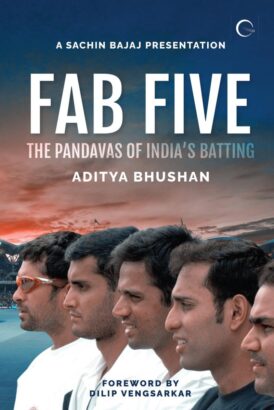Fab Five: The Padavas of India’s Batting
Martin Chandler |Published: 2024
Pages: 217
Author: Bhushan, Aditya
Publisher: Global Cricket School
Rating: 3.5 stars

I was soon struck, after I had started reading Fab Five, how quickly the memory can fade. The turn of this century is not so long ago, yet the fact that around that time an Indian batting line up included all of Sachin Tendulkar Rahul Dravid, Sourav Ganguly, Virender Sehwag and VVS Laxman is something I had if not forgotten then certainly lost sight of. All are hallowed names, and despite Indian cricket generally having gone from strength to strength since they all retired even an Englishman has special memories of all five.
All five men have been the subject of books before, many in the case of Tendulkar, and several for Dravid and Ganguly, so Aditya Bhushan, who has previously written biographies of CK Nayudu and Anshuman Gaekwad as well taking a look at the great Indian spinners of the 1960s and 1970s, might have simply sought to showcase the lives of the five. I suppose in a sense that is what he has done, but in truth the book is in many ways a history of Indian cricket from the time of Tendulkar’s debut until the IPL arrived and changed the game forever.
The sub-title of the book draws a comparison with five brothers whose family were the victors in an epic war from Hindu legend. All five had distinct characters. Helpfully for those of us who are not familiar with the legend Aditya does take some time to explain it, but I will leave it to those who are more familiar with the story of Yudhishthir, Bheem, Arjun, Nakul and Sahadev to comment on how apposite or otherwise the comparisons are.
That there were and are marked differences in the personalities and batting styles of the five are however beyond doubt, and Fab Five is certainly a good reminder of those. To begin with, and for several years, there was of course just Tendulkar, and as the others joined him there was the spectre of the controversies that saw a sad end to the career of Mohammad Azharuddin and it is only after that is explained that the major part of the book follows, the detailed analyses of the style, techniques and characters of the Fab Five, and the drawing of the comparisons with the Pandavas.
Aditya concludes with a chapter reflecting on the era he has described and looking specifically at just a few of the more important matches the five played in, one of which I certainly recall well, that being India’s innings victory over England at Headingley in 2002 when Dravid, Tendulkar and skipper Ganguly all made hundreds.
As many as 35 pages then make up a statistical appendix, containing a myriad of numbers relating to the Fab Five which will doubtlessly keep entertained those who have a fondness for that sort of thing. Personally I would have preferred most of those pages to be have been utilised to extend the very last chapter, which looks at the far from obvious but in fact highly relevant question of the cricketers whose career progress was impeded by the Fab Five.
In taking that step Aditya proceeds to look at two men who did appear for India, Wasim Jaffer and Subramanian Bandrinath, and two who didn’t, Mithun Manhas and Azol Mazumdar. But there must be a number of others who would have been well worth mentioning, the names of Deep Dasgupta, Sanjay Bangar, SS Das and Sadagoppan Ramesh being four names that immediately occurred to me.
But that is merely an observation and not a criticism. All in all Fab Five is a well written, interesting and entertaining look back at an immensely powerful Indian batting line up that gave great pleasure to cricket lovers the world over






Leave a comment